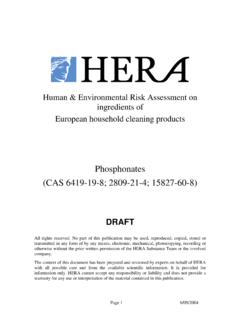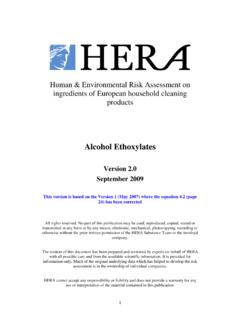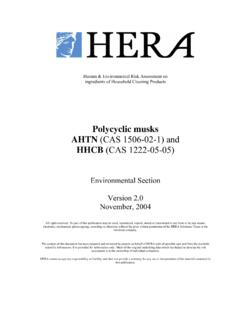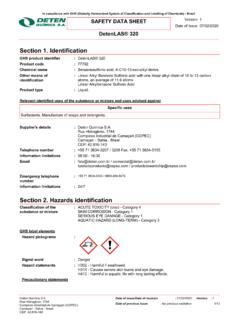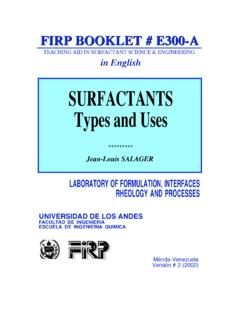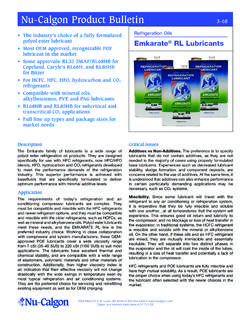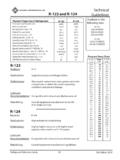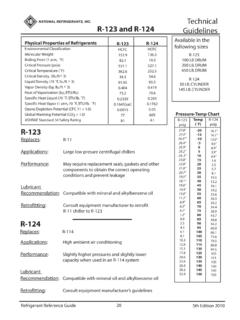Transcription of LAS - HERA project
1 1 LAS Linear alkylbenzene Sulphonate (CAS No. 68411-30-3) Revised HERA Report April 2013 2 1. Contents 2. Executive summary 3. Substance characterisation CAS No. and grouping information Chemical structure and composition Manufacturing route and production/volume statistics Consumption scenario in Europe Use application summary 4. Environmental safety assessment Environmental exposure assessment Biotic and abiotic degradability Removal Monitoring studies Exposure assessment: scenario description Substance data used for the exposure calculation PEC calculations Bioconcentration Environmental effects assessment Ecotoxicity Aquatic ecotoxicity Terrestrial ecotoxicity Sediment ecotoxicity Ecotoxicity to sewage microorganisms Reassurance on absence of estrogenic effects PNEC calculations Aquatic PNEC Terrestrial PNEC Sludge PNEC Sediment PNEC STP PNEC Environment risk assessment 5.
2 Human health assessment Consumer exposure Product types Consumer contact scenarios Consumer exposure estimates Direct skin contact from hand washed laundry Direct skin contact from laundry tablets Direct skin contact from pre-treatment of clothes Direct skin contact from hand dishwashing Indirect skin contact from wearing clothes Inhalation of detergent dust during washing processes Inhalation of aerosols from cleaning sprays Oral exposure to LAS Inhalation and skin contact from laundry pretreatment products: Spray spot removers Skin contact from laundry pretreatment products: Liquid spot removers 3 Inhalation and skin contact from liquid cleaner products: Oven cleaner (spraying) Skin contact from from liquid cleaner products: Oven cleaner (cleaning) Inhalation and skin contact from liquid cleaner products: Bathroom cleaners (mixing & loading) Inhalation and skin contact from liquid cleaner products: Bathroom cleaners (cleaning) Inhalation and skin contact from liquid cleaner products: Floor cleaners (mixing) Inhalation and skin contact from liquid cleaner products.
3 Floor cleaners (cleaning) Accidental or intentional overexposure Hazard assessment Summary of the available toxicological data Toxicokinetics Acute toxicity Acute oral toxicity Acute inhalation toxicity Acute dermal toxicity Skin irritation Eye irritation Sensitisation Repeated dose toxicity Oral route Inhalation Dermal route Genetic toxicity In vitro In vivo Carcinogenicity Reproductive toxicity Developmental toxicity and teratogenicity Oral route Dermal route Identification of critical endpoints Overview on hazard identification Adverse effects related to accidental exposure Determination of NOAEL or quantitative evaluation of data Risk assessment Margin of exposure calculation Risk characterisation Systemic toxicity Local effects Acute effects Summary and conclusions 6. References 7. Contributors to the report Substance team HERA environmental task force HERA human health task force 4 Industry coalition for the OECD/ICCA SIDS assessment of LAS 2.
4 Executive Summary Linear alkylbenzene sulphonate (LAS) is an anionic surfactant. It was introduced in 1964 as the readily biodegradable replacement for highly branched alkylbenzene sulphonates (ABS). LAS is a mixture of closely related isomers and homologues, each containing an aromatic ring sulphonated at the para position and attached to a linear alkyl chain. The European consumption of LAS in detergents applications covered by HERA was about 350 kt in 2005. This represents more than 80% of the total European consumption of LAS, which was estimated to be about 430 kt in the year 2005. LAS is one of the major anionic surfactants used on the market. Important application products are household detergents, such as laundry powders, laundry liquids, dishwashing products and all-purpose cleaners. The minor other final uses of LAS, namely in the field of textile and fibres, chemicals, and agriculture, are outside HERA s scope.
5 Environmental assessment The present environmental risk assessment of LAS is based on the HERA methodology document, which in its turn is based on the EU Technical Guidance Document (TGD, 2003). It makes use of the EUSES programme following the HERA detergent scenario (EUSES, 2008). LAS concentrations (PEC values) measured or modelled in the various environmental compartments were compared with extrapolations of the many available eco-toxicity data leading to PNEC values protective of each compartment. In raw sewage, the LAS concentration was in the range of 1-15 mg/l. When the sewage was properly treated in activated sludge STPs (Sewage Treatment Plant). LAS was highly removed leading to an effluent concentration in the mg/l range. LAS concentration was further decreased by dilution in the receiving waters where it could be found in the < mg/l concentration range.
6 LAS degrades rapidly aerobically (half-life in rivers about 3 hours), whereas it does not degrade under anaerobic conditions, except under particular conditions. Typical LAS concentrations in aerobic sludge are < g/kgdw sludge (dry weight). In STP anaerobic sludge, the calculated median LAS concentration was g/kgdw sludge (dry weight) ( g/kgdw sludge at 95th percentile). During sludge transportation to the farmland, sludge storage, and application on agricultural soil, aerobic conditions are restored and rapid degradation of LAS resumes. In sludge-amended soils, LAS had a maximum half-life of one week (primary biodegradation) and monitored concentrations were around 1 mg/kgdw soil (maximum mg/kgdw soil) at harvesting time. No accumulation in soil and no bioaccumulation in plants could be detected experimentally.
7 In freshwater sediments, measured LAS concentrations typically ranged from <1 mg/kgdw sed. to a maximum value of mg/kgdw 5 Ecotoxicity data are abundant and well documented. The aquatic PNEC value ( mg/l) was calculated from: i) a statistical extrapolation including a set of high quality single species chronic data and ii) the no-observed effect concentration of a stream community experimentally exposed to LAS. The terrestrial PNEC value (35 mg/kgdw soil) was calculated from: i) the equilibrium partitioning method , ii) statistical extrapolation of a set of high quality chronic data on plants and soil fauna , iii) an expert judgement on the toxicity of several microbial processes and functions, and 4) field toxicity studies. The sludge PNEC value (49 g/kgdw sludge) was back-calculated from the soil PNEC on the basis of the EU TGD scenario (TGD, 2003).
8 The sediment PNEC value ( mg/kgdw sed.) was calculated from i) the lowest available chronic effect value and an application factor, and ii) the equilibrium partitioning method, the PNEC was normalized for organic carbon content. The STP PNEC ( mg/l) was calculated from acute and chronic microbial inhibition data and the use of the relevant application factor (TGD, 2003). The risk characterisation as expressed by the PEC/PNEC ratio was below 1 for all environmental compartments. It was concluded that the ecotoxicological parameters of LAS have been adequately and sufficiently characterized and that the ecological risk of LAS is judged to be low. Human health assessment The presence of LAS in many commonly used household detergents gives rise to a variety of possible consumer contact scenarios including direct and indirect skin contact, inhalation, and oral ingestion derived either from residues deposited on dishes, from accidental product ingestion, or indirectly from drinking water.
9 The consumer aggregate exposure from direct and indirect skin contact as well as from inhalation and from oral route in drinking water and dishware results in an estimated total body burden of mg/kg bw/day. This body burden is substantially higher than the body burden of g/kg bw/day reported in the previous version of this HERA document. The higher estimated body burden is a result of using information from the RIVM report Cleaning Products Fact Sheet (RIVM,2006) to assess the risk to consumers in additional to the AISE overview concerning habits and practices on uses of detergents and surface cleaners in Western Europe (THPCPWE,2002). Furthermore, some additional use scenarios have been identified. The toxicological data show that LAS was not genotoxic in vitro or in vivo, did not induce tumours in rodents after two years daily dosing, and failed to induce either reproductive toxicity or developmental or teratogenic effects.
10 The critical adverse effect identified after repeated long term high dosing of LAS to animals was a change in renal biochemical parameters. A systemic NOAEL of 68 mg/kg bw/day was established. Comparison of the aggregate consumer exposure to LAS with the systemic NOAEL results in an estimated Margin of Exposure (MOE) of The estimated Margin of Exposure is based on conservative estimations of both exposure and NOAEL (which is a systemic NOAEL given the existence of oral toxicokinetic data). This MOE is substantially less than the MOE of 17000 6 reported in the previous version of of this HERA document. The lower MOE is a direct result of the higher estimated body burden (see above). Neat LAS is an irritant to skin and eyes. The irritation potential of aqueous solutions of LAS depends on concentration. Local effects of hand wash solutions containing LAS do not cause concern given that LAS is not a contact sensitizer and that the concentrations of LAS in such solutions are well below 1% and therefore not expected to be irritating to eye or skin.




